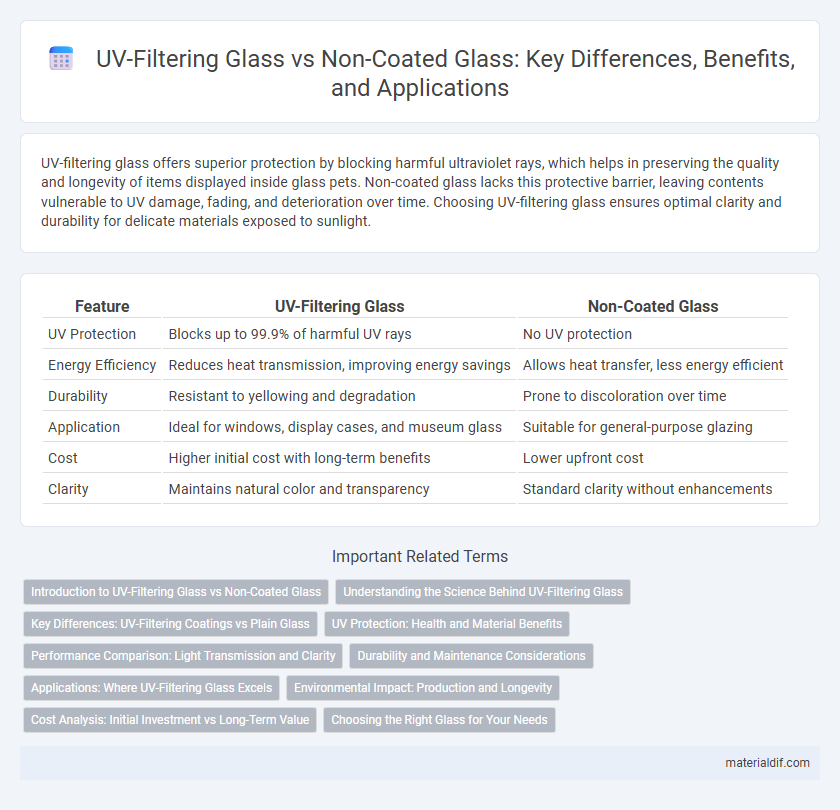UV-filtering glass offers superior protection by blocking harmful ultraviolet rays, which helps in preserving the quality and longevity of items displayed inside glass pets. Non-coated glass lacks this protective barrier, leaving contents vulnerable to UV damage, fading, and deterioration over time. Choosing UV-filtering glass ensures optimal clarity and durability for delicate materials exposed to sunlight.
Table of Comparison
| Feature | UV-Filtering Glass | Non-Coated Glass |
|---|---|---|
| UV Protection | Blocks up to 99.9% of harmful UV rays | No UV protection |
| Energy Efficiency | Reduces heat transmission, improving energy savings | Allows heat transfer, less energy efficient |
| Durability | Resistant to yellowing and degradation | Prone to discoloration over time |
| Application | Ideal for windows, display cases, and museum glass | Suitable for general-purpose glazing |
| Cost | Higher initial cost with long-term benefits | Lower upfront cost |
| Clarity | Maintains natural color and transparency | Standard clarity without enhancements |
Introduction to UV-Filtering Glass vs Non-Coated Glass
UV-filtering glass significantly reduces ultraviolet radiation transmission, protecting interiors from UV-induced fading and damage, while non-coated glass allows higher levels of UV rays to pass through. Typical UV-filtering glass employs coatings or embedded materials that absorb or reflect UV light, enhancing durability and comfort in residential and automotive applications. In contrast, non-coated glass lacks these protective features, making it less effective for environments requiring UV protection.
Understanding the Science Behind UV-Filtering Glass
UV-filtering glass incorporates advanced coatings that selectively block harmful ultraviolet rays while maintaining visible light transmission, effectively reducing UV-induced damage to interiors. Non-coated glass allows nearly all UV radiation to pass through, increasing the risk of fading and material degradation over time. The science behind UV-filtering glass relies on thin-film technology or embedded UV absorbers that absorb or reflect UV radiation, enhancing protection without compromising clarity.
Key Differences: UV-Filtering Coatings vs Plain Glass
UV-filtering glass incorporates specialized coatings that block up to 99% of harmful ultraviolet rays, significantly reducing UV transmission compared to non-coated glass. Plain glass lacks these treatments, allowing most UV radiation to pass through, which can lead to accelerated fading of interiors and increased health risks. The UV protection properties make UV-filtering glass ideal for preserving furnishings and enhancing occupant safety in residential and commercial buildings.
UV Protection: Health and Material Benefits
UV-filtering glass blocks up to 99% of harmful ultraviolet rays, significantly reducing skin damage and preventing fading or deterioration of interior furnishings. Non-coated glass allows most UV radiation to pass through, increasing risks of skin cancer and accelerating material degradation. Choosing UV-filtering glass enhances both health safety and longevity of household items.
Performance Comparison: Light Transmission and Clarity
UV-filtering glass significantly reduces harmful ultraviolet rays while maintaining high light transmission, typically around 85-90%, ensuring clear visibility without color distortion. Non-coated glass allows higher UV penetration, causing potential fading of interiors and reduced long-term clarity despite similar initial transparency. The advanced coating on UV-filtering glass enhances optical performance by minimizing glare and improving overall visual comfort compared to standard non-coated alternatives.
Durability and Maintenance Considerations
UV-filtering glass enhances durability by reducing degradation from ultraviolet rays, preventing discoloration and material weakening over time. Non-coated glass lacks this protection, making it more susceptible to damage from UV exposure and requiring frequent cleaning to maintain clarity. Maintenance of UV-filtering glass is generally lower due to its protective layer, which also helps preserve structural integrity and appearance longer than non-coated alternatives.
Applications: Where UV-Filtering Glass Excels
UV-filtering glass excels in applications requiring protection from harmful ultraviolet rays, such as museum displays, art galleries, and retail showcases where preserving the integrity of sensitive materials is crucial. It is ideal for automotive and residential windows to prevent interior fading and improve occupant comfort. Compared to non-coated glass, UV-filtering glass significantly reduces UV radiation penetration without compromising visible light transmission, enhancing both protection and visibility.
Environmental Impact: Production and Longevity
UV-filtering glass reduces environmental impact by extending the lifespan of interior materials and decreasing the frequency of replacements, which lowers waste generation and resource consumption. The production of UV-filtering glass involves advanced coating technologies that may have a slightly higher initial carbon footprint compared to non-coated glass, but its durability and protective properties contribute to long-term sustainability. Non-coated glass lacks UV protection, leading to faster degradation of furnishings and increased environmental costs over time due to more frequent manufacturing and disposal cycles.
Cost Analysis: Initial Investment vs Long-Term Value
UV-filtering glass typically involves a higher initial investment compared to non-coated glass due to advanced coatings and manufacturing processes. Over time, the enhanced protection against UV radiation reduces fading of interiors and lowers cooling costs, resulting in significant long-term savings. Evaluating the cost-benefit ratio highlights that UV-filtering glass delivers superior value through durability and energy efficiency despite its upfront expense.
Choosing the Right Glass for Your Needs
UV-filtering glass blocks up to 99% of harmful ultraviolet rays, protecting interiors from fading and reducing skin damage risks. Non-coated glass lacks this protection, allowing UV rays to penetrate and compromise furnishings and health over time. Selecting UV-filtering glass is essential for environments requiring enhanced durability and occupant safety against UV exposure.
UV-filtering glass vs Non-coated glass Infographic

 materialdif.com
materialdif.com